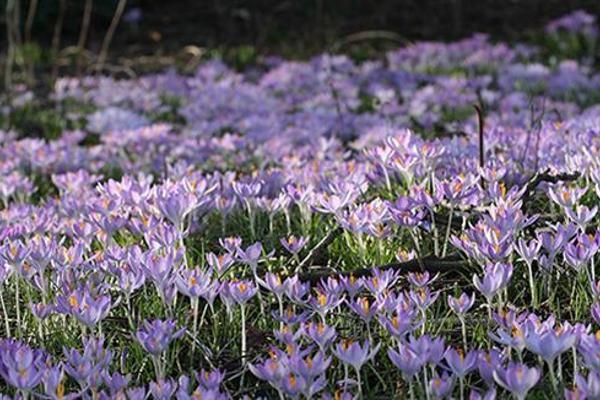A bunch of crocus for Puduhepa
Aylin Öney Tan - aylinoneytan@yahoo.com


The crocus flower is the flower of joy. It is the first flower to emerge in spring, bringing cheerfulness as a sign of spring. I’ve long been suggesting that it must be the flower for Women’s Day, but of course that is not possible commercially. My reason for associating crocus with women is all about Hittites. Gathering crocus flowers and bulbs is a traditional folk activity in Anatolia in early spring, usually done by a bunch of sprightly kids, hopping happily in the fields. The tradition is a good old one that goes back to Hittite times, one of Anatolia’s earlier inhabitants. Hittite women were powerful and strong, and played significant roles in society. The foremost Hittite queen, Puduhepa, who married King Hattusili III is regarded as the most influential women known from the ancient Near East. She lived in 13th century B.C., almost 33 centuries ago.
The Hittites had four seasonal major festivities, two of them dedicated to welcome spring. The spring festivals were the an.tah.sum or the “crocus festival,” and the Purulli festival. Of the two celebrations, the an.tah.sum festival was performed “for the sun goddess of Arinna and the gods of the Hatti Land.” The festivities lasted about thirty-eight days; its rites took place in Hattusa and other important religious centers of the Hittite homeland. Spring festival celebrated the regeneration of the powers of nature. It was a time of renewals, of reconfirmation of the gods’ endorsement of the king’s authority, of regeneration of the life, health and vigor of the king and his consort. There was a direct connection between the king’s wellbeing and the rhythm of nature that was essential to the growth process. The crocus bulb and flower, as symbols of renewal and awakening, played an important role in this spring festivity. The festival lasted for 38 days, with the festival procession passing through various towns and finally culminating in Arinna where the flower was presented to the sun goddess. In stone reliefs, bunches of three to twelve crocus flowers are depicted clearly. It is not hard to imagine that they ate their flowers too!
The fascinating thing is, in the same geography, within the former boundaries of the mighty Hittite empire, the folk tradition of gathering crocus flowers in a festive way, still survives. Children go out in the fields and decorate bare dry branches of trees with bright yellow crocus flowers, and go in groups to houses to gather ingredients for the festive dish of bulgur pilaf with crocus bulbs and flowers. They chant songs and quatrains about “çiğdem,” the crocus flower. Finally when all the ingredients are complete, the spring pilaf is cooked communally in the village square. What could be a more cheerful way to meet spring?
Puduhepa carried the title of “Tawananna,” a lifelong title of Hittite queens, even kept after the death of the king. After the death of her husband, Puduhepa held her title and ruled the Hittite kingdom. She was a great diplomat who took on responsibility of communicating with the Egyptians and establishing marital connections the Egyptian royal family. She surely knew how to renew, regenerate, and reestablish her power. Her legacy prevails in Anatolian women today. After all, if we still have the crocus gathering tradition, we might still have a drop of Puduhepa in our blood!
Bite of the Week
RECIPE OF THE WEEK: This dish may have roots in the Hittite world. “Yoğurtlu çiğdem aşı,” a crocus bulb and yogurt stew, is a regional dish from Gaziantep (old Aintab) that was almost forgotten. Aintab is home to many important Hittite remains and the name itself may be derived from Khantap meaning “king’s land” in the Hittite language. At one time, bunches of wild crocus bulbs were sold in local markets in spring, but they are getting less and less available now. One would expect that the bulbs would have an oniony flavor but on the contrary, they are quite starchy. The flavor and texture of the cooked bulbs resemble fresh chestnuts, or even water chestnuts. It is a refreshing spring dish, quite plain, but astonishingly tasty. Soak ½ cup chickpeas in water overnight. Wash 500 g lamb, cut into bite sized pieces and place in a pot with water to cover. Bring to the boil and carefully skim off any froth that forms on the surface. Finely chop 1 onion and add to the meat, together with the drained chickpeas and 1 ½ teaspoons salt. Cook until tender. Now the exciting and toilsome part: you have to clean about 2 kg of crocus bulbs. Peel off the outer skin of the bulbs, remove the stems and wash well. Add the bulbs to the cooked meat. Continue to cook until bulbs are cooked. Meanwhile, beat 1 egg and 3 cups of strained yogurt in a pot until smooth and cook over a gentle heat, stirring constantly in one direction, occasionally blending in a tablespoonful of the cooking liquid from the stew. When the yogurt begins to bubble, stir into the meat, chickpea and crocus stew and continue to stir the ingredients altogether until it comes to a boil. Remove from the heat. Melt 2 tablespoons butter in a small pan. Remove from the heat and stir in dried safflower petals (usually and mistakenly sold as Turkish saffron, “aspir” in Turkish) and black pepper, then drizzle over the stew and serve. If you cannot get a hold of safflower, use dried mint instead.



